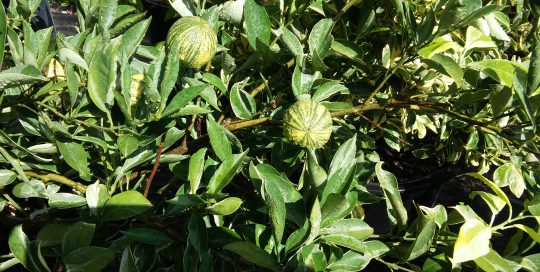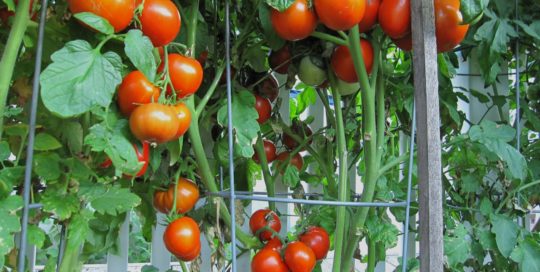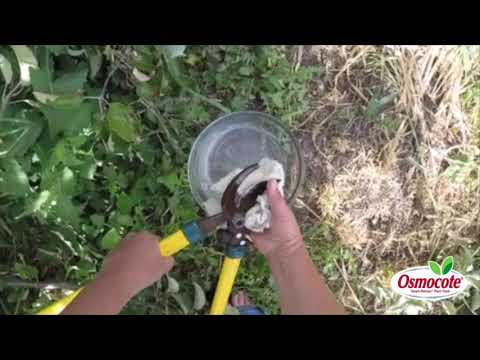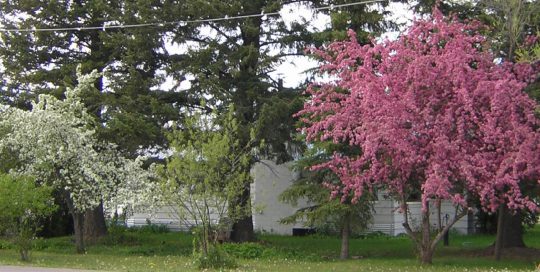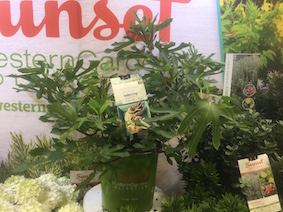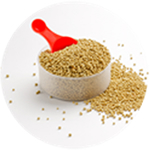Growing your own fruit doesn’t necessarily require dedicating the space and resources of a full blown orchard. By focusing on small fruits, you can enjoy a bounty of sweet harvests throughout the entire growing season. In this article Amy Grisak challenges, “Why not add fruit plants to your garden this season?”
Raising some of these smaller fruits, along with scrumptious berries, is possible for any gardener. You can use nothing but containers or in garden beds. Many of the varieties are adaptable with different growing habits and sizes. This allows them to work into a number of situations. The key is to choose the ones that work best for your growing style, as well as what you want in a homegrown fruit. If you plan carefully, you can harvest from the early summer all the way until frost.
Strawberries
Fresh strawberries from your own garden can only be described as sublime. Warmed by the summer sun, they are sweet and perfect. Thankfully, they produce extremely well, as long as you have a little patience.
There are several types of strawberry varieties, and the key is picking the right one for how you want to use them. If making a big batch of strawberry jam is your goal, opt for the June-bearing varieties that produce a large flush of berries within a short amount of time so you can harvest enough to use. If snacking on them for weeks is more your style, go with the ever-bearing types. They spread out their blooms and berries for weeks, sometimes even to the end of the summer. Day-neutral berries start early in the season produce in waves, typically every few weeks and can produce some nice, big fruit.
To plant strawberries, spend the time and effort to amend the soil, whether it’s in a container, in the ground, or in a raised bed. Strawberries produce best when they have ample nutrition to develop the big, luscious berries. Find plants at your local nursery or order them online. Space them 12-18 inches apart (this might mean only 1-2 plants per container, depending on the size) and dig a hole large enough to the spread the roots. Plant the strawberry up to the crown burying the flared out roots.
Consistently water the plants since their shallow roots are susceptible to drying out, and fertilize them regularly (time-released Osmocote works very well – in fact, it’s what professional growers use). In arid regions, mulch is also a wise choice in order to retain as much moisture as possible.
If you have the patience, pinch off the blooms the first season. It’s painful to miss out on fruit the first year, but it allows the plants to focus all of their energy into root development. Another draconian practice is to eliminate the daughter plants sent out on runners for the same reason. You can replant these, though, if so desired.
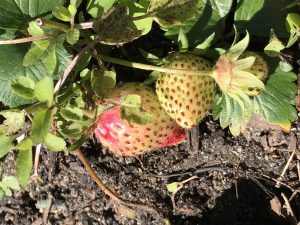
Strawberries Ripening – Photo from PlantersPlace Library
Gooseberries
These cousins of the currant are very popular in Europe. But, they can be hard to find at local Farmer Markets, or other typical produce outlets. That’s a good reason to grow your own. The round fruit can be a light green to a blush rose boasting a tangy grape-like flavor with a sweet undertone. Gooseberries are delicious as fresh snacks and make out-of-this-world pies and tarts.
There are two types, the European and American varieties. The American ones having the reputation of generally being hardier and better adapted to various conditions. They also accompanying higher levels of production. The European varieties are typically bigger and more flavorful. Pick the type that works the best for you.
If you’re going to grow gooseberries, choose a variety that is resistant to blister rust. Blister rust is a fungal disease that that affects white bark pine species. Because of this relationship, gooseberries and currants were banned in the United State around 1900 until the ‘60s. The disease decimated these important pine species. There are still areas where gooseberries are illegal, so check with your local extension office before planting.
Gooseberries prefer more humid regions, and can grow in full sun to even part shade, making them a good addition to a home food forest. Give them room, roughly 5-6 ft. between plants, and prune them when they are dormant to encourage a more open growing habit and higher production.
Currants
Like gooseberries, currants thrive when planted in fertile soil in a sunny area, but not with a harsh southern or western exposure. For best results, ensure they have a consistent water supply. Plant 3-4 ft. apart, depending on the variety.
There are a number of varieties of currants within the 4 prominent types – black, white, pink, or red currants. The black currants typically have the strongest flavor and are best for jellies or pies. White currants are usually larger and juicier and better for fresh eating. Like the black currants, red ones are best used in recipes, and the pink are in between the red and the white in their flavor and uses.
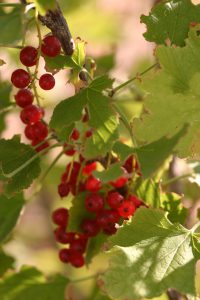
Currants – Photo by Amy Grisak
Nanking cherries
If you’re looking for a beautiful shrub that produces delicious fruit, consider the Nanking cherry. Hardy from Zones 3-7, it grows up to 12 ft. tall (if you don’t prune it). It is covered in dainty white blossoms in the early spring around the time when daffodils are blooming. The fruit is less than 1/2 inch in diameter, but tastes like pie cherries making absolutely delicious jellies.
Grow them in full to partial sun with 4-5 ft. between the shrubs, and be sure to provide consistent watering. They thrive in nearly any soil type, except in those that have poor drainage, but it’s always a good idea to amend the soil with organic matter before planting. Be sure to provide enough space to walk around them to harvest.
American plums
While not every gardener has the room for conventional plum trees, it’s easy to plant the native American plum to provide an ample harvest of these small and tasty fruits. They can range from a few feet tall to over 20 ft., depending on the region, and tend to grow in more of a thicket habit. There isn’t a main trunk like on a tree.
Native plums are smaller and have a tart flavor, and make fantastic jams and other preserves, including fruit leather. White flowers form in the early spring, and the plums usually ripen towards the end of the summer. The greatest challenge is keeping the deer from eating the fruit before you do, and unless you have a large planting of these prolific shrubs, you’ll want to put some sort of fence – electric or a complete barrier – around them to be able to pick some for your family, and not Bambi’s.
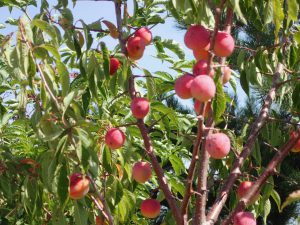
Native Plumbs – Photo by Amy Grisak
Grapes
Grapes are a magical crop. They are possible in practically every home garden as long as they have ample support. From seedless varieties, such as Somerset, that are good for eating, to more specialized types bred for wine or jelly making, it’s a treat to have your own grape growing space, even if it’s just a plant or 2.
Give grapes plenty of space, at least 6 ft. apart, and grow them on a sturdy support. Plant them in the early spring (often March in many regions) in fertile, well-amended, well-drained soil. Dig a hole roughly a foot deep and the same width across since the roots need to take a good hold to create a healthy plant. Mulch to help even out the moisture level in the soil.
The hard part about grapes is it’s best not to allow them to produce fruit for the first couple of seasons. Plus, they thrive with severe pruning. Grapes don’t produce on second year canes, so remove those in the late winter or early spring while they’re still dormant.
Once the plants are producing grapes the greatest challenge is keeping the birds from eating them, so consider using a bird netting or some other barrier between them and the tasty fruit.
Chokecherries
It’s always wise to look at native plants for excellent varieties to grow at home because they require far less fussing, yet give you a bountiful harvest. Chokecherries are an excellent example. They grow abundantly along rivers and waterways, as well as in the open, drier terrain. But, they are far easier to pick in your backyard.
Chokecherries grow the best in sunnier conditions, although they do tolerate shade to some degree. They typically do not require supplemental water, unless you reside in a semi-arid climate or go for a prolonged period without rainfall. And although they can easily grow 20 ft. tall, they thrive with pruning. You can literally mow them to the ground, and they’ll come back strong.
In the spring, pretty clusters of white flowers hang down and eventually form the groups of dark fruit. To harvest, simply pull the berries off of the clusters. It usually doesn’t take long to pick a bunch of a chokecherries since you an strip off so many at a time.
Processing them is the tricky part because there is a rather large pit firmly encased in the pulpy berries. Some people crush and strain the fruit trying to sort out the two, but the easiest way is to put the berries, stems, seeds and all, in a steam juicer. The beautiful liquid makes an excellent jelly or syrup.
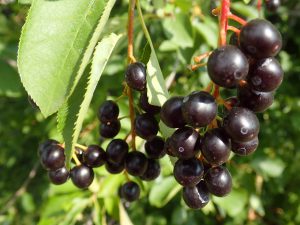
Chokeberries – Photo by Amy Grisak
Raspberries
Other than strawberries, raspberries are one of the most popular small fruits to grow in a home garden. Red, golden, or black, they are a delicious addition to the edible garden.
Summer bearing varieties tend to take center stage with an enormous burst of fruit usually in July, but you can prolong your raspberry harvest until a hard freeze by adding fall-bearing types to your collection. You can even grow some varieties, such as Shortcake, in a large container. For whatever variety you choose, raspberries like full sun, consistent watering, and fertile soil to grow the best berries.
For raspberry plants growing directly in a bed look for an area with full sun, and depending on the variety, some sort of support for the sprawling types that can grow to become unwieldy. A fence along one side works for a narrower bed. Alternatively, T-posts on either side of the row will keep the plants in line.
Plant bare-root canes 18-24 inches apart in a zig-zag pattern along a wide row. They will spread rapidly so it’s best to give them space. For most varieties provide an inch of water a week, although in drier regions increase this amount to mitigate rapid evaporation.
Pruning is key to a healthy raspberry patch. Summer bearing raspberries require the removal of the old canes from the previous year. It also requires thinning out the new ones allowing 4-6 new, strong canes per plant. While you can trim back the height of the plant, don’t be too harsh. The best production is at the top third of the plant. While it’s wise to keep the bush from becoming too gangly, you also don’t want to eliminate future berries.
Fall-bearing varieties are very different. Although you can prune them in a similar fashion as summer bearing raspberries, to encourage a mid-summer harvest the best aspect about them is the glorious final berries before the freeze. To encourage this habit, cut them back to 3-4 inches high either at the end of the season or in the early spring before the plants begin growing. They grow rapidly throughout the summer and create a last hurrah for the growing season.
Blackberries
Like raspberries, blackberries can be a bountiful and delicious crop, particularly for more moderate climates in Zones 5-10. They do not grow well in alkaline soils or where winter temperatures frequently dip below zero.
When growing blackberries, there are three types to choose from, depending on your area and preferred growing style. Erect thorny blackberries are similar to the wild (not native, but they grow abundantly in some areas of the country). To encourage increased production, cut-out last year’s canes, then trim back a few inches of the tops of the remaining new canes when they are about 3-4 ft. tall
Semi-erect blackberries don’t grow to the same height as the erect types, and are often found in thornless varieties. Trim the plants when they are 4 ft. tall (this is something you might have to do throughout the summer), and consistently take out the suckers that spring up throughout the season.
Trailing blackberries, which are also often thornless, need support to be able to easily pick them. Use T-posts and wire to be able to keep the bushes from flopping over. Like the other varieties, remove the canes that bore fruit when the plant is dormant, either at the end of the season, or during the winter.
Like raspberries, provide plenty of water and fertilizer, and be ready to harvest every couple of days. It’s a welcomed task to enjoy this sweet treat!
Even if you can’t have a full-fledged orchard in your backyard, you can grow any number of these small fruits. Make a little space in your garden or utilize large containers to add fresh fruit to your summer selections.

